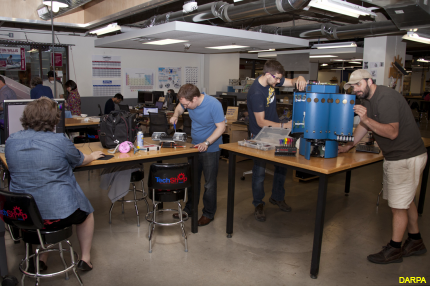DARPA to fast-track robotics innovations
By shortening the contracting and development process, the agency wants to engage “nontraditional performers” in rapid, low-cost development of breakthrough technologies.

DARPA is looking to attract the kind of usually untapped resources found in the agency-funded TechShop in Arlington, Va., a community workshop.
Despite some great leaps forward in robotics in recent years, Pentagon researchers feel they’ve been missing something—innovations from small, possibly underfunded groups that don’t normally work with the federal government or deal with its years-in-the-making development process.
The Defense Advanced Research Projects Agency wants to help bring those companies and individuals into the fold, while at the same time speeding up its development and acquisition process and cutting the costs of development, with its new Robotics Fast Track, or RTF, program.
“We spend too much time creating three- to four-year solutions for six-month problems,” Mark Micire, DARPA program manager, said in a news release. “We want this new generation of robotics innovators to see DARPA as a partner that can help them develop breakthrough technologies in the areas that personally interest them and help translate their ideas and know-how into game-changing capabilities. We’re eager to pioneer this new approach, which could lead to rapid, marked improvements in national security as a whole.”
RFT, currently a pilot, would streamline the contracting process to accommodate what DARPA calls nontraditional performers, spending an average of $150,000 each on projects that could deliver prototypes and proofs of concept in six to 12 months. The contracting process itself, from the time a proposal is submitted (via a website) to when a contract is signed, would take less than a month, Micire said. DARPA didn’t give a total funding amount for RFT, but plans to fund a number of projects over the next year.
The agency has brought in the non-profit Open Source Robotics Foundation (OSRF) to help work with those organizations that aren’t used to working with the government but which nevertheless could produce groundbreaking technologies that could meet the needs of the military.
“Lots of smart people have good ideas for advancing the state of the art, but aren't ready to invest the time and effort necessary to navigate the government's traditional contracting mechanisms,” said Brian Gerkey, CEO and founder of the foundation. “Through RFT, we aim to support these people, explore their ideas and change the landscape of robotics at a pace that wasn't previously possible.”
DARPA is looking for robotics innovations that can work for ground, sea or air operations, make use of open source tools and open architectures, and possibly could augment existing commercial technologies. Among its other areas of interest are technologies that improve robotic sensing, perception, planning and communication. The agency also is interested in technologies that might not be specifically military but could support other national security functions, such as law enforcement and emergency response.
If the program goes as planned, RFT could lead to a significantly larger program that builds on the public-private robotics community, DARPA said. The Army, Navy, Homeland Security Department, NASA and other government organizations have already expressed interest in reviewing technologies that emerge from RFT.
Anyone interested in participating in RTF can apply here.
Meanwhile OSRF will have representatives at the DARPA Robotics Challenge, June 5-6, in Pomona, Calif., to discuss RFT. Twenty-five teams of industry, university and government scientists will be competing in the challenge.




